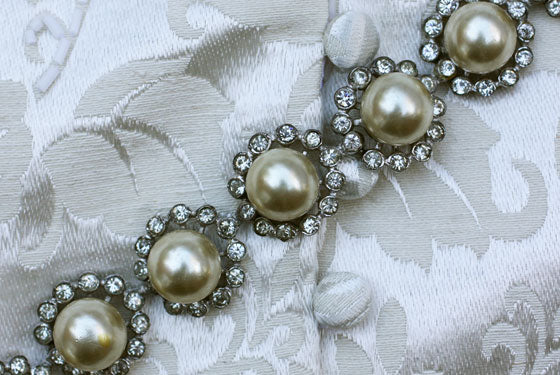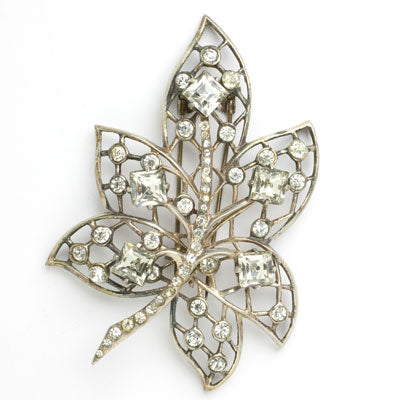
Women’s History Month inspired me to highlight one of the most brilliant female jewelry designers you have never heard of. Ruth Kamke was the fiercely-talented woman behind the sparkling creations of Eisenberg Jewelry, Inc. for over three decades. Let me start by telling you a bit about her employer.
Fallon & Kappel
Eisenberg & Sons, a Chicago-based dress manufacturer established in 1920, contracted with other companies to design and produce their dress ornaments and jewelry. Fallon & Kappel (F&K) was one of their suppliers and a leading jewelry maker of the day, creating for fashion houses such as Chanel, Hattie Carnegie and Schiaparelli. Eisenberg became the firm's client in the 1930s when the dress company launched a separate jewelry line.
“Using only the most magnificent imported stones, incredible molding techniques, and detailed finishing work, [F&K] established themselves at the top level of costume jewelry manufacturing … Jewelry with the Eisenberg Original mark could cost the equivalent of a woman’s monthly salary” (Schwartz & Sutton 195). The photo above shows their spectacular Pearl Bracelet with Diamanté in Sterling (sold). Here are two more examples of their premium quality pieces in the TruFaux Jewels boutique.
The graceful leaf brooch on the left is substantial in weight and size (3 ½” x 2 ½”) and was made in two layers with square and round diamanté accents. Earrings like those on the right were challenging because they required separate designs for the right and left ear, to frame the wearer’s face.
Enter a Brilliant Young Designer, Ruth Kamke
In January 1940, F&K hired 15-year-old Ruth Kamke (née Wortmann) as an enameller. “Ruth grew up surrounded by fashion books and trunks of wonderful fabrics, and by a love and appreciation of detail, style and, most importantly, of fantasy” (Tollemache 3). Her mother was a dressmaker and designer, and Ruth had studied fashion and design in high school.
After only one week on the job, the firm offered her a position as their first in-house designer. Until that time, they had been using only freelancers, which was common in the industry. Many of their designs, though beautiful, could not be manufactured for a variety of reasons. Kamke’s success at F&K was due to her incredible talent as well as her technical knowledge. She worked closely with the model makers and learned the aspects of production required to take a design from drawing to finished product cost-effectively. Not unusually, in her early years with the firm, she couldn’t afford any of the jewelry she created for them.
The War Years
World War II significantly impacted Eisenberg Jewelry in several ways. First, the supply of base metals, used in most costume jewelry making since the 1920s, was limited to the war effort. Costume jewelers had to switch to sterling silver, which Eisenberg used until 1948. Importation of magnificent stones from Austria (Swarovski in particular) came to a halt. The shortage of materials forced F&K and Eisenberg to sign a mutually exclusive contract – the former would supply only Eisenberg, who would buy from only F&K. At the same time, Kamke became the client’s sole designer.
I am not alone in believing that Eisenberg pieces produced from 1943-1948 are among the finest costume jewelry ever made. These big, bold and beautiful designs by Ruth Kamke were created with the finest quality stones hand set in sterling silver. Sophisticated and timeless, they were in vogue in the era and are coveted and worn with pride by collectors today.
 Diamanté & Sterling Sunburst Eisenberg Earrings (sold)
|
|
Here are two additional examples which, like all featured in this article, were Kamke’s work. The earrings on the left illustrate how the shape of a stone influenced her. The large amethyst and diamanté bow on the right (sold) is a lovely example of her use of colored stones, which she particularly liked.
The End of an Era
Kamke continued to work for F&K until 1972, when the firm suddenly closed, thus ending her connection to Eisenberg. After two years as a freelance designer, she accepted a position with Panetta, where she stayed until her retirement in 1987. She died in 2017.
Her Legacy
Thanks to the authors cited below, Kamke’s name has not been lost to history. The Tollemache article, which was based on exclusive interviews, documents her story in detail. After it was published, the next issue of the magazine included her letter of thanks to the many readers who had contacted her. In it Kamke stated: “Knowing that my creations are still alive and well and are meaningful to so many people is overwhelming. I am gratified, since designing consumed a good portion of my life. Your responses have made me feel it was all worthwhile”.
I am so pleased she received these well-deserved accolades in her lifetime for jewelry design talent that still sparkles to this day.
For More Ruth Kamke Jewels
Visit the boutique’s Eisenberg Jewelry collection.
Quoted Sources
Schwartz, Sharon G. and Laura Sutton. Eisenberg Originals: The Golden Years of Fashion, Jewelry, and Fragrance, 1920s-1950s. Schiffer Publishing, 2017.
Tollemache, Nicholas and Linde. “The Designs of Ruth Kamke”, Vintage Fashion & Costume Jewelry, vol. 10, no. 1, Winter 2000.




9 comments
Wish I had met her, too. Thanks for writing!
I was at that VFCJ convention, and was so very honored to meet Ruth Kamke! Thank you for this article.
Thanks for writing, Carolyn!
Your delightful backstory is now in my faux jewelry files ? I’m crazy for vintage and now here in 2021, antique jewelry, from the early half of the 20th Century. Eisenberg is my new fascination and am starting a small collection, budget permitting. I look forward to more of your writing and expertise!
Thanks very much, Patricia!
Leave a comment